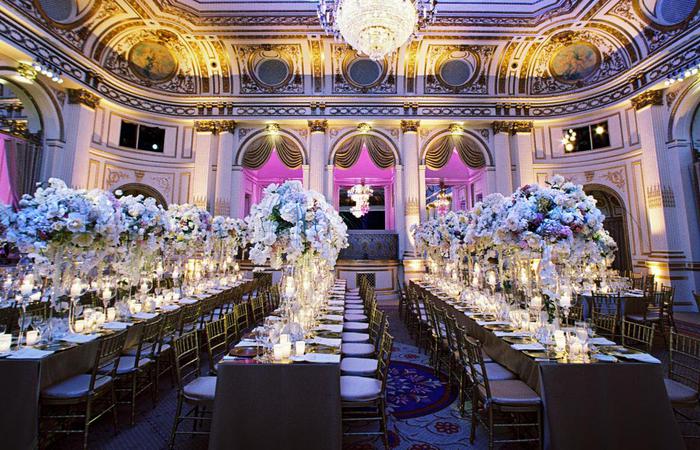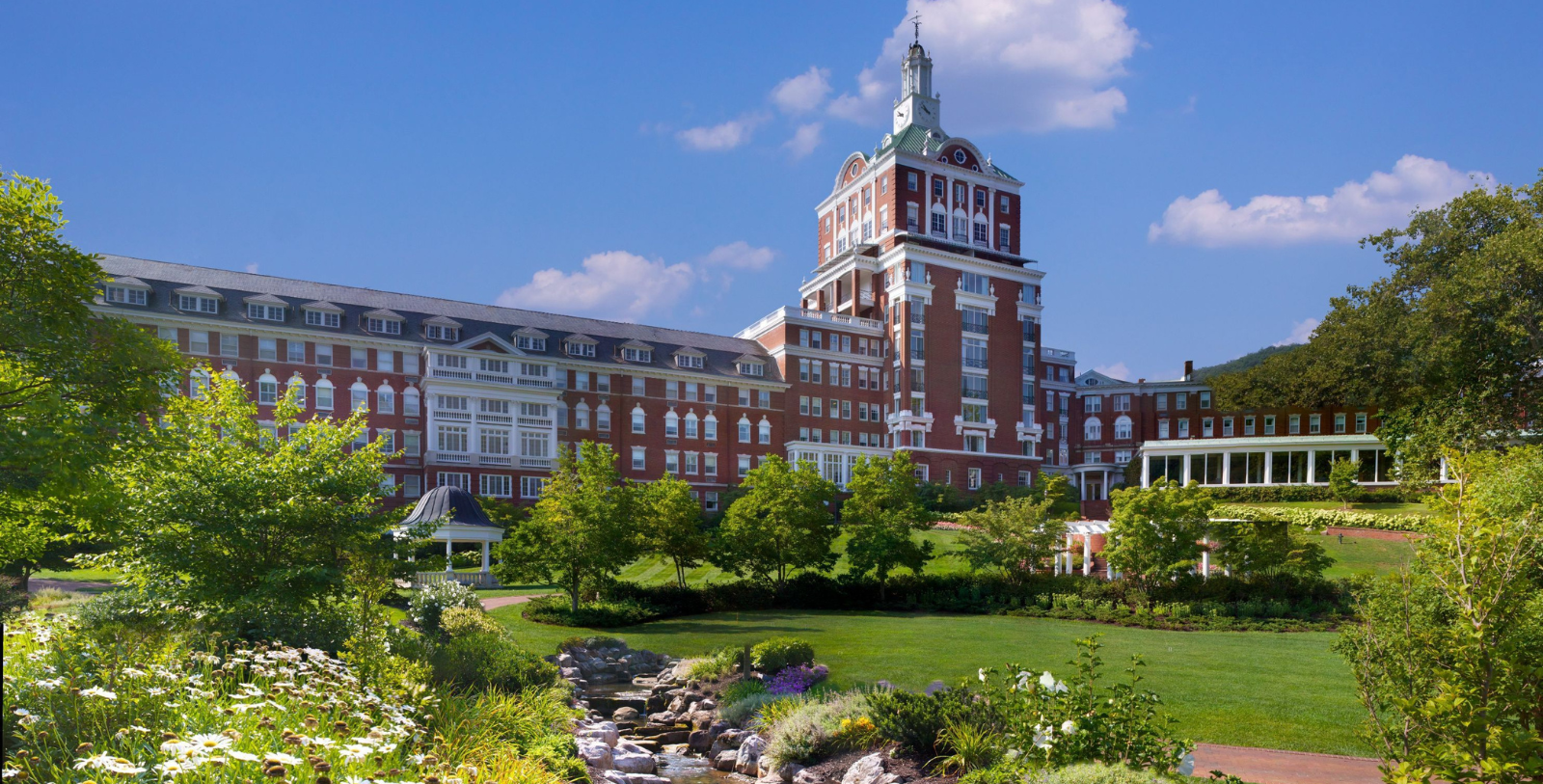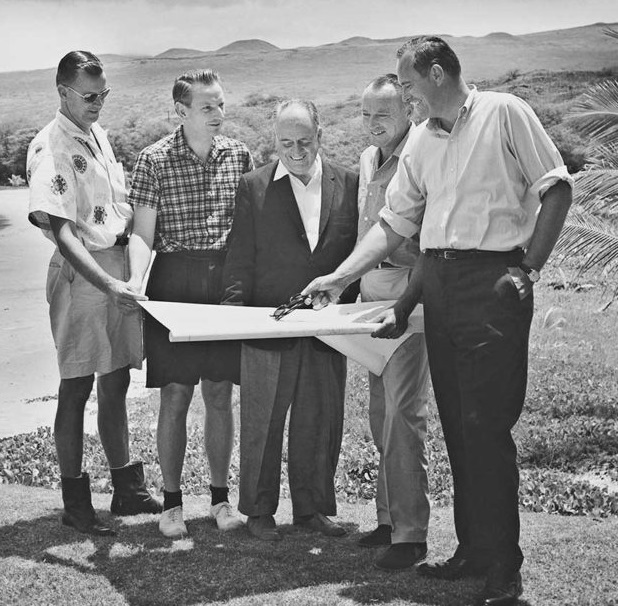Receive for Free - Discover & Explore eNewsletter monthly with advance notice of special offers, packages, and insider savings from 10% - 30% off Best Available Rates at selected hotels.
historic mauna kea beach hotel
Discover the Mauna Kea Beach Hotel with its classic mid 20th century architecture, modernized to accommodate 21st century guests.
Mauna Kea Beach Hotel, a member of Historic Hotels of America since 2016, dates back to the 1964.
VIEW TIMELINEThe History of Mauna Kea Beach Hotel
Starting quite literally from scratch, learn how Laurance S. Rockefeller’s vision for Mauna Kea Beach Hotel came to life.
WATCH NOWThe Historic Mauna Kea Beach Hotel has been a member of Historic Hotels of America since 2016, the Mauna Kea Beach Hotel was founded by visionary venture capitalist and environmentalist Laurance S. Rockefeller. On a visit to the Island of Hawai’i, he spotted the tranquil crescent of Kauna‘oa Bay. He visualized an elegant, luxury resort hotel that reflected the spirit of that incredible location. But while Kauna'oa Bay possessed a gorgeous beach, there were no roads, no power, and most importantly, no fresh water. Everything had to be transported onsite, and everything had to be developed from scratch. Leasing the land from Richard Smart, Rockefeller nevertheless began creating plans as early as 1960. At first, he embraced the blueprints of architect John Carl Warnecke, who wanted to construct a series of small cottages near the shoreline. Yet, Rockefeller eventually abandoned the idea when he saw Skidmore, Owings and Merrill’s avant-garde vision for a singular resort hotel. He quickly hired one of the firm’s most talented architects, Edward Charles Bassett, to bring the plan to life, and assigned Davis Allen—another employee of Skidmore, Owings and Merrill—to be the lead interior decorator. The open-air design that Bassett created for the resort hotel’s exterior was nothing short of breathtaking. It immediately influenced the travel industry throughout the Hawaiian Islands, as many hoteliers sought to emulate the building’s sleek appearance over the next several decades.
Calling his beautiful new resort hotel the “Mauna Kea Beach Hotel,” Rockefeller formally debuted the business in July of 1965. The first retreat to debut on the Island of Hawai’i, thousands of people quickly flocked to the building to reserve a guestroom. Praised by travel writers and critics worldwide, it was named one of the “Three Greatest Hotels in the World” by Esquire, as well as one of the “10 Best Buildings of 1966” by Fortune. And in 1967, it received an award from the American Institute of Architects. But Rockefeller did not simply stop with his resort hotel. Fully committed to transforming Kauna‘oa Bay into a preeminent vacation retreat, he had also commissioned the renowned landscape architect Robert Trent Jones to create a championship-caliber golf course. Named the “Mauna Kea Golf Course,” the beautiful collection of fairways had debuted just a year before the Mauna Kea Beach Hotel opened. Jones had developed a brilliant method for turning lava rock into soil, enabling him to create a spectacular series of greens that enchanted golfers from all over. Rockefeller even commemorated the launch of his amazing golf course with a televised “Big 3” match between Arnold Palmer, Jack Nicklaus, and Gary Player.
In 1978, Laurance S. Rockefeller sold his beloved resort hotel to United Airlines. Shortly thereafter, United placed the Mauna Kea Beach Hotel within its Western International Hotels subdivision, which was later renamed as just “Westin Hotels.” Following the transfer, the location operated as “The Westin Mauna Kea” throughout much of the 1980s. Then, in 1990, Yoshiaki Tsutsumi of the Seibu Railway acquired the location and operated it through his company, Prince Hotels. Yet, his ownership proved to be brief, as all the Prince Hotels in Hawaii and Alaska were reacquired by Westin Hotels at the end of the decade. The Mauna Kea Beach Hotel continued to operate as one of Hawaii’s leading getaways until the great Kiholo Bay earthquake struck the archipelago in 2006. With the tourism industry slowed to a standstill, the staff at the Mauna Kea Beach Hotel took the opportunity to initiate a massive, $150-million renovation. Lasting for a couple of years, the construction did much to both modernize the resort, while also preserving its rich historical character. It subsequently reopened to great acclaim in December of 2008. Now managed by Marriott International’s Autograph Collection, the Mauna Kea Beach Hotel proudly remains as one of Hawaii’s most luxurious resort hotels.
-
About the Location +
The region of Kohala resides on the northern end of the Island of Hawai’i within the greater Hawaiian archipelago. Local Hawaiians cultivated the countryside for centuries, using a system of terraced farming and ditch irrigation to grow such products like taro, bananas, and sweet potatoes. Dozens of historical Hawaiian settlements also dotted the landscape, including an ancient fishing village named “Lapakahi.” But plantation farming and sustenance fishing were gradually replaced with a commercialized agricultural society that appeared with the arrival of foreigners at the end of the 18th century. The very first recorded traveler to visit was Captain James Cook, an English mariner hired by the Earl of Sandwich to explore the Pacific Ocean. (Although there is some dispute today as to whether the Spanish navigator Ruy López de Villalobos found the islands first.) In the years following Cook’s landing, many Europeans—and later Americans—started settling the Hawaiian Islands, including Hawai’i and its Kohala region. The new inhabitants erected massive estates that specialized in growing cash crops like sugarcane. Cattle raising also emerged in popularity on Hawai’i around the same time, too, with the first ranches opening in 1793. Unlike the American and European plantation owners, the people who established the earliest ranches were from Mexico. They trained the native Hawaiians in the art of cattle ranching, giving rise to the culture of the “paniolos.” Regarded as the Hawaiian “cowboy,” many paniolos still call Hawai’i home to this very day.
Perhaps the greatest historical accolade of the Kohala region is that it was once home to Paiʻea Kamehameha, otherwise known as “Kamehameha the Great.” Born in Kohala during the 1750s, Kamehameha was responsible for uniting the Hawaiian archipelago into a single society. Upon the death of his uncle, King Kalaniopuu, in 1782, the island of Hawai’i was effectively split between Kamehameha and his cousin, Kiwalao. While the two relatives lived in peace for some time, the actions of their supporters eventually forced both men to go to war. In what became known as the “Battle of Mokuʻōhai,” Kamehameha’s army routed Kiwalao’s forces. Nevertheless, Kamehameha struggled to control the eastern half of the island, which was under the influence of Kiwalao’s half-brother, Keōua Kuahuʻula. After a series of inconclusive battles, Kamehameha constructed a massive temple complex called “Puʻukoholā Heiau” to reinforce his political power. (It is currently federally protected as a National Historic Landmark.) He then attacked Kuahuʻula’s men a final time at the Battle of Kawaihae and won. Now the suzerain of Hawai’i, Kamehameha subsequently embarked on a great crusade to seize the other neighboring islands. Conquering places like Maui and Oahu, Kamehameha managed to forge a unified kingdom by 1810. King Kamehameha proceeded to lead the region into a cultural renaissance, instituting a system of laws and founding a well-funded treasury. Kamehameha even protected Hawaii’s sovereignty by facilitating peaceful diplomatic relations with a few European nations and the young United States.
Kohala itself was named after the main dominating geological feature in the region—Kohala Mountain. The first of Hawai’i’s five major volcanoes to manifest, Kohala is currently believed to have existed for centuries. According to geologists, the volcano has been around so long that it experienced the flip of the Earth’s magnetic field some 780,000 years ago! (Kohala Mountain has laid dormant for over 120,000 years, posing no real threat to the surrounding environs.) Not only is Kohala Mountain ancient, it is also incredibly large. Shaped like a foot, the volcano covers some 234 square miles and 3,400 cubic miles in volume. Amazingly, Kohala Mountain constitutes just under 6% of Hawai’i’s total land mass. But experts hypothesize that the volcano may have stood even larger, as recent evidence has suggested that a landslide reduced its summit by 3,300 feet. Contributing to the mountain’s unique shape has been extreme erosion, which occurred over the course of millennia. The activity has created subsequently several other amazing geological features, too, including the verdant Polulu and Waipiʻo valleys. Scientists have even uncovered a wealth of historic maritime fossils imbedded into the crust of Kohala Mountain, offering a fascinating glimpse into Hawaii’s prehistoric environment. Contemporary local conservationists have since taken great pains to preserve the area’s rich ecology for future generations to appreciate.
-
About the Architecture +
Upon swimming in the warm, tranquil waters of Kauna’oa Bay, Rockefeller knew he had discovered a great place for a magnificent holiday retreat. Rockefeller quickly signed a 99-year lease with the local landowner, Richard Smart, who operated a ranch in the area. He hired a crew of meteorologists to test the area’s weather patterns before construction began, in order to see if air conditioning—and other similar amenities—were necessary for his nascent resort. As a committed naturalist, Rockefeller disdained modern technology, seeing it as nothing more than an unhealthy distraction. Instead, his goal was to blend the atmosphere of the serene environment with pure sunlight and fresh, tropical air. At first, it seemed that the architect John Carl Warnecke had conceived of the perfect way in which to actualize Rockefeller’s dream, calling for the creation of a small seaside village of remote rental cottages. But the firm of Skidmore, Owings and Merrill eventually convinced Rockefeller to build a sleek resort hotel. The company’s proposed “megastructure” would number 154 guestrooms that possessed openings to floors that seemed to float over a waterfront atrium. The firm also called for the entire exterior to feature white paint, so as to mimic the sands of Kauna’oa Bay. A freestanding dining pavilion also appeared within the design, structured to resemble a Buddhist temple. And the blue-tiled lobby possessed Hawai‘i’s first retractable roof, as well as a skylight that could be closed whenever it rained. When work finally commenced on the Mauna Kea Beach Hotel, the construction crews utilized 54,000 square feet of Mexican flagstone, 5,000 square feet of Italian marble, and 30,000 even square feet of local lava stone. Additional building materials included one mile of Narra wood, 11 miles of piping, and nearly 1,700 tons of reinforced steel. Skidmore, Owings, and Merrill even used more than 20,000 cubic yards of concrete! The roof of the Mauna Kea Beach Hotel also possessed many beautiful black beach pebbles acquired from over 90 miles away. In all, it took some 1.5 million man-hours to build the resort hotel, as well as more than $15 million—roughly $155 million today!
The Mauna Kea Beach Hotel itself can best be described as displaying “avant-garde” architectural aesthetics. While most architectural historians have typically stated that “avant-garde” and “modernism” are one and the same, recent scholarship has postulated that the two are actually very different. Avant-garde design principles were a radical and disruptive phenomenon, which sought to remake art for ordinary people to appreciate. Modernism on the other hand, was far less groundbreaking, as it evoked a smoother artistic taste. The avant-garde is also far more nebulous, as many sub-architectural forms are part of the movement. Everything from Neoplasticism to Expressionism is considered a contributing component to “avant-garde” architecture. The Mauna Kea Beach Hotel embraced the avant-garde in many ways, designed to render its opulent appearance accessible to a modern, mass audience. Its layout made explicit use of vertical, flat lines and irregular rectangular shapes that conveyed a lack of formality. Overt ornamentation was abandoned, too, as monochromatic brickwork, steel, and concreate served as the essential building blocks for the exterior. Inside, most of the rooms were subdivided into split levels, giving a sense that the structure had undergone as significant change in elevation. Modernist buildings also featured wide, open spaces filled with natural light that represented practicality and comfort. Large widows often functioned as the primary way in which the architects achieved such a feature. Most of the rooms were also subdivided into split levels, giving a sense that the structure had undergone as significant change in elevation. The introduction of spacious windows even sought to better incorporate nature into the design, making the surrounding landscape seem as if it were part of the building itself.
-
Famous Historic Guests +
Laurance S. Rockefeller, heir to the Rockefeller family fortune and investor in such successful business like Intel and Apple.
Robert Trent Jones, renowned golf architect who designed over 500 golf courses in 45 U.S. states and 35 other countries.
Jack Nicklaus, winner of 18 major golf championships—the most of any professional golfer.
Arnold Palmer, winner of seven major golf championships that include the PGA Championship and the Masters Tournament.
Gary Player, winner of nine major golf championships that include all four of the major tournaments.
-
Art Collection +
In the early 1960’s Mauna Kea Beach Hotel’s developer, Laurance S. Rockefeller, envisioned the hotel as a “private estate offering a cross-cultural experience.” To help achieve his vision, his team of experts acquired original artifacts and sculptures from Asia, Oceania, the Pacific Rim and Hawaii to adorn the hallways, entryways, nooks and crannies of his dream destination resort. Hundreds of museum-worthy pieces from the priceless collection are displayed throughout the hotel. Several are most notable among the collection; an enormous 12th-century pink granite Buddha from India that is reposed beneath a Bodhi (enlightenment) tree at the summit of the hotel’s grand stairway; two gold-gilded prayer disciples that flank the lobby entry and welcome guests; and, Hawaii’s largest standing collection of Hawaiian quilts, each made especially for Mauna Kea Beach Hotel. There are also Maori canoe prows, bronze Indian dowry chests and New Guinea shields, among many other numerous pieces. A recent partnership with Honolulu’s famed Bishop Museum has brought about stabilization and enhanced displays of the hotel’s treasured collection of traditional Hawaiian kapa (pounded bark) cloth. The Mauna Kea Beach Hotel art collection was the first of its kind ever assembled for a hotel anywhere in the world. Honoring Rockefeller’s vision, the pieces are still displayed in a manner that encourages self-discovery. Visitors wishing to learn more are welcomed to join a complimentary art tour each Saturday morning. On the hotel’s website, links to a half dozen podcasts allows visitors to delve even more deeply into the collection’s history and its pieces.





































